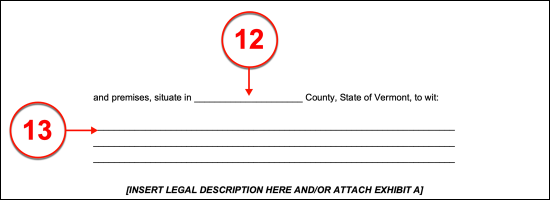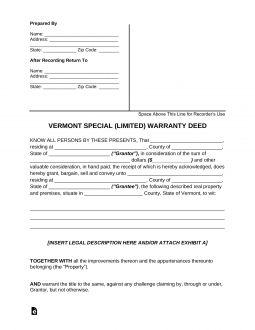Updated April 12, 2024
A Vermont special warranty deed allows the transfer of ownership from a grantor (seller) to a grantee (seller) with limited guarantees. The deed absolves any liability on the grantee from claims made during the grantor’s ownership period.
A special warranty deed does not protect the grantee from claims made prior to the grantor’s ownership.
Laws – Title 27 (Property), Chapter 5 – Conveyance of Real Estate
Real Estate Taxes (Form PT-172) – For the deed to be processed the Real Estate Taxes needs to be filed with the Department of Taxation. After payment, this form should be attached to the deed and can be filed online.
Recording – All deeds are to be filed in the County Clerk’s Office in the jurisdiction of where the property is situated.[1]
Signing – All deeds in the State of Vermont are to be acknowledged before a notary public.[2][3]
How To Write
Download; PDF, MS Word, OpenDocument
I. Preparation Of Vermont Property Filing
(1) Identity Of Vermont Document Preparer. The transfer statement below shall require input to define the concerned Vermont transaction. The Preparer of such information will need to self-identify at the start of this document’s header.
(2) Business Address. A record of the Vermont Document Preparer’s active business address should be displayed in the first section. Several spaces shall call for specific address items to be placed where requested as a matter of convenience for the Reviewer.

II. Vermont Recorded Document Recipient
(3) Recorded Statement Recipient. Once it is registered with the State of Vermont the County Recorder will seek to return the submitted paperwork to a Recipient of the executing Grantor’s choosing. Dispense the name of this individual as the Recipient meant to receive this recorded statement.
(4) Mailing Address. Naturally, the Vermont County Recorder shall need the street address, state, and zip code of the formally named Recipient. Provide these items to the second area of this header.

III. Vermont Grantor Issuing Statement
(5) Vermont Grantor Identity. The name of the Seller of the Vermont real property is required by the first declaration of this paperwork. Every Owner of the Vermont property intending to use this document must be identified here even if additional space must be inserted or a roster of all Vermont Grantors must be attached.

(6) Street Address And County. In addition to identifying every Vermont Grantor by name, his or her home address is needed as a means to identify him or her reliably in this statement. Use the next two available areas to produce the street address (made up of his or her building number, street, and apartment number) and the County of the Vermont Grantor’s home address. Keep in mind, that if more than one Vermont Grantor is involved, then an attachment containing the remaining roster must include each Grantor’s home address.
(7) State Of Vermont Grantor Residence. Make sure the State where each Vermont Grantor lives is documented as well.

IV. Payment Made To Vermont Grantor
(8) Record Of Submitted Consideration. The transaction revolving around the Vermont real property requires discussion. Document the payment that was paid and received by the Vermont Grantor in exchange for the real property. Write this amount out on the blank line preceding the parentheses then enter this value numerically between the parentheses.

V. Grantee Acquiring Vermont Property
(9) Vermont Grantee Identity. The Vermont Grantee must be designated by this document to acquire ownership of the concerned real estate. The declaration of conveyance must therefore be supplemented with the name of the Vermont Grantee authorized to present this document as proof of his or her ownership of the real estate. Keep in mind the discussed ownership remains at the same level the Grantor was able to claim over the property before signing this document.

(10) Street Address And County. To avoid any confusion regarding the Vermont Grantee’s identity, his or her residential street address and County must be documented. Each Vermont Grantee must be identified by name and home address for the purpose of this document.
(11) State Of Residence Of Vermont Grantee.

VI. Vermont Real Property
(12) Vermont County. The full name of the County where the Vermont property can be visited is required to aid in discussing this property.
(13) Legal Description Of Vermont Property. Locate the last deed registered for this property. Ideally, it will be in possession of the Vermont Grantor. The legal description it contains to define the Vermont property should be transcribed to the area provided. If, for some reason, the Vermont Grantor does not have ready access, this same legal description can be found in the books held by the Vermont County Recorder.

VII. Execution Of Vermont Property Transfer
(14) Vermont Grantor Signing. The completion of this paperwork is dependent on the Vermont Grantor. When ready, the Vermont Grantor should gather with a Notary Public then sign his or her name as well as print it.
(15) Home Address Of Vermont Grantor. The Vermont Grantor who has signed the document must also submit his or her full address.

(16) Required Vermont Notarization. The State of Vermont shall require that the signature of the Grantor be properly submitted. To this end, every Vermont Grantor must be able to prove his or her identity to the satisfaction of a Notary Public at the time of signing, then release this document to the observing Notary so that it may be completed with the credentials and information that only a qualified Notary Public may provide.



